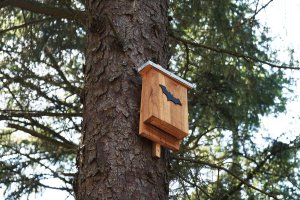Rich and Diverse Wetlands
Victoria Taylor Sluder, HCMA District Interpretive Services Supervisor- Western District
“What are these tiny biting gnats? Is there something in my yard that attracts them or is this a seasonal thing that everyone just deals with? Wind doesn’t seem to affect them, and when flattened, they are full of blood. They leave welts and are tenacious. We need more bats.”
Recently this comment was posted on a public social page. Do you agree? About the bats? There is more to this issue than meets the eye.
 A neighbor related in conversation how she thought the bat roosting box she put up in her yard would be good way to prevent mosquito bites this summer. Do you think so? You actually have better options.
A neighbor related in conversation how she thought the bat roosting box she put up in her yard would be good way to prevent mosquito bites this summer. Do you think so? You actually have better options.
Of course, bats are essential members of their natural communities. The roles they play as predators of nocturnal insects and as prey to owls are vital. It is important for all nine species of Michigan bats to have healthy populations in our state.
But putting your expectations all on bats as a control to biting flies is giving too much credit to bats and not enough where it is due. What it implies is that if there are a lot of bugs, the bats aren’t there, or there aren’t enough of them, or they are not doing their job.
That would be a misconception. Here’s why. Many organisms have a direct effect on the number of flies, positive and negative. That’s “organisms,” because plants as well as animals are included. There are also many non-living factors involved, too. Bugs that like to bite us, such as mosquitoes, biting midges AKA “no-see-ums,” and deer flies, are aquatic for part of their life cycles. The flying adults are only one part. The other is their immature life, which is spent under water. To beat the potential for this water to dry up before they are finished growing up, the time flies spend maturing is short and can be measured in just days.
Video of mosquito larvae underwater
Puddles of water, like the amount inadvertently collected in a forgotten Frisbee in the yard can be a terrific breeding ground for hundreds of mosquitoes in a short while. That is why you can have a small impact on these populations just by removing items from your yard that would collect and hold water unnecessarily. Especially since these items support biting flies like mosquitos, but not their predators.
With diversity, an ecosystem is at its best, and healthy ecosystems balance predator and prey species. Proper wetlands are needed for those fly predators to thrive. That means the presence of fully submerged aquatic plants, minute floating plants and algae, marching rows of stemmed plants on the water’s edge and shrubs and trees on the edge whose branches shade the water and whose roots help retain it. All are necessary for diverse communities of insects to live on and around, as well as the animals “higher” in the food chain, such as birds, spiders, fish, frogs, dragonflies, and bats. There are also bacteria and fungi that are involved in natural controls: killing and limiting biting fly populations.
Rich and diverse. These are the terms scientists use when speaking of quality ecosystems. Rich meaning the number of each living species present, and diverse meaning the variety of species. And an ecosystem is a community of interdependent living things and the non-living features with which they interact. In this setting, just having riches isn’t necessarily that great. An ecosystem rich with flies and not much else, for example, would not be a quality ecosystem. With diversity many kinds of living things are present, and an ecosystem is at its best.
Swarms of biting bugs can easily plague us in spaces that have very little other nature. Rainwater collects in a clogged gutter, a discarded tire, or a toy in the yard. These are hardly rich and diverse ecosystems. If biting flies live as members of wholesome communities, they are matched against other forces in the community that limit the ability of any single population to grow out of balance for long. On the other hand, biting insects have adaptations that that allow them to use human-created places – giving them an unnatural advantage with no competition. That’s when things run amok and people turn to unnatural options to deal with them, such as chemicals.
What is a better solution? We must appreciate that when natural wetlands are thriving the balance is as it should be and biting bugs don’t get to live unchecked. So yes, you can support those bats with roosting boxes. And absolutely, be vigilant about removing trapped puddles of water from your yard. But above all else, look for ways that you can support rich and diverse natural spaces. Choose no-mow and pesticide-free options and go organic in your buying choices. Try adding a native garden rather than just turf and support parks that preserve your natural spaces.
It is up to people, not bats, to make and support the space for healthy thriving ecosystems.
If you want to know more about how the Metroparks are working to do better and changes we are making to support rich and diverse natural communities, keep exploring our website and reading about our natural resource plans, upcoming interpretive programs, and public Board of Commissioner meeting information.
